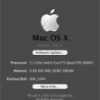Leopard on Pre-Series 7 NVIDIA nForce MCP + Intel CPU MOBOs
Survey of nForce chipset desktop MOBO Ownership
386 members have voted
-
1. Which nForce chipset + CPU MOBO desktop system do you have?
-
Series 7 nForce chipset + Intel CPU MOBO?83
-
Series 6 nForce chipset + Intel CPU MOBO?222
-
Series 5 nForce chipset + Intel CPU MOBO?6
-
Series 4 nForce chipset + Intel CPU MOBO?6
-
Series 7 nForce chipset + AMD CPU MOBO?11
-
Series 6 nForce chipset + AMD CPU MOBO?16
-
Series 5 nForce chipset + AMD CPU MOBO?17
-
Series 4 nForce chipset + AMD CPU MOBO?20
-
I have a Series 600M nForce chipset + AMD S1 CPU laptop/notebook MOBO6
-
nForce chipset + CPU combo MOBO not listed above8
-
-
2. What is your nForce chipset desktop MOBO system CPU?
-
Intel Penryn (Wolfdale)9
-
Intel Penryn (Yorkdale)2
-
Intel Core 2 Extreme (Quad)14
-
Intel Core 2 Extreme (Dual)3
-
Intel Core 2 Quad112
-
Intel Core 2 Duo166
-
Intel Pentium D9xx4
-
Intel Pentium D8xx5
-
Intel Pentium 47
-
Intel Celeron D2
-
AMD Phenom7
-
AMD Athlon 64 FX3
-
AMD Athlon 64 X252
-
AMD Athlon 646
-
AMP Sempron1
-


Recommended Posts